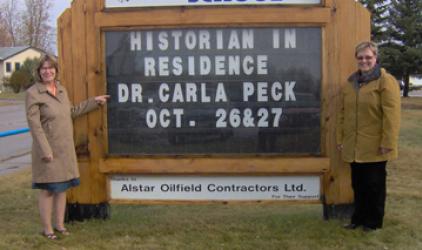Research in Practice: Doing History at Fox Creek School (Carla Peck)

Dr. Susan Nobes, Principal of Fox Creek School in Fox Creek, Alberta invited me to be “Historian in Residence” at her school over a two day period in the fall of 2009. Dr. Nobes ordered artifact kits from the Glenbow Museum in Calgary, Alberta (one on the Métis, one on the Fur Trade, and one on the Blackfoot) and I brought with me a kit full of Inuit artifacts from the University of Alberta library as well as some old toys I’d picked up from an antique store in Edmonton. I planned lessons and developed “data collection charts” that I hoped would be appropriate for elementary school children to learn how to think historically.
What is Historical Thinking?
For decades, historical understanding has been thought of primarily in terms of factual recall. That is, how much could students remember (or forget) from their encounters with history in school or elsewhere? But recall does not tell us anything about our (or our students’) capacity to think historically.
The unique nature of the discipline was also an important consideration from a pedagogical standpoint. The argument that pedagogical methods could be designed without considering what was being taught did not hold up under close scrutiny. In fact, the opposite was (and is) true. History education researchers then and now feel strongly that content and pedagogy cannot be separated because historical knowledge develops most successfully by doing history – or using the discipline’s (or historian’s) tools to construct historical knowledge.
Educators and researchers that work in the area of historical understanding have outlined several concepts that underpin the discipline, concepts that are different than the substance of history (such as “revolution” or “World War II”) and instead provide a framework for investigating the past. These include evidence, historical significance, continuity and change, cause and consequence, historical perspective taking, and the ethical dimension of history. For the past four years, I have been involved in a pan-Canadian project called the Historical Thinking Project whose concepts have proven to be very effective in helping both teachers and students better understand the nature of historical inquiry.
Classroom Activities
For the younger students (grades 1 to 2), I brought different types of toys to class and had them look for “clues” to figure out which toys were from “Long Ago” and which were from “Today.” With the older students (grades 3 to 6), I used artifacts from the Glenbow Museum and University of Alberta to ascertain questions one can ask about an artifact in order to gain insight into the person, people and/or society that may have used/created the object. With all students, I ended each class by asking a question that would connect the particular to the general: What can we learn about [boys and girls from long ago, the Inuit, the Métis, the fur trade, etc.] by examining these toys/artifacts? By so doing, I was able to help students make some generalizations based on the evidence they’d collected about the group/time period under study.
Concluding Remarks
Historical understanding is not only about learning to think like an historian. It is also about how we use historical knowledge to understand how things used to be, why things are the way they are now, and to decide what shape we want our future to hold. If my experience at Fox Creek School is any indication, students are waiting and wanting to be engaged in active historical inquiry that challenges them to reshape their understandings of the past. An “historical thinking” approach that employs evidence and artifacts enables teachers to meet this challenge, and places learning squarely in students’ hands.
The full text of this article will appear in One World, the Alberta Teachers’ Association’s Social Studies Council journal, in fall 2010.

